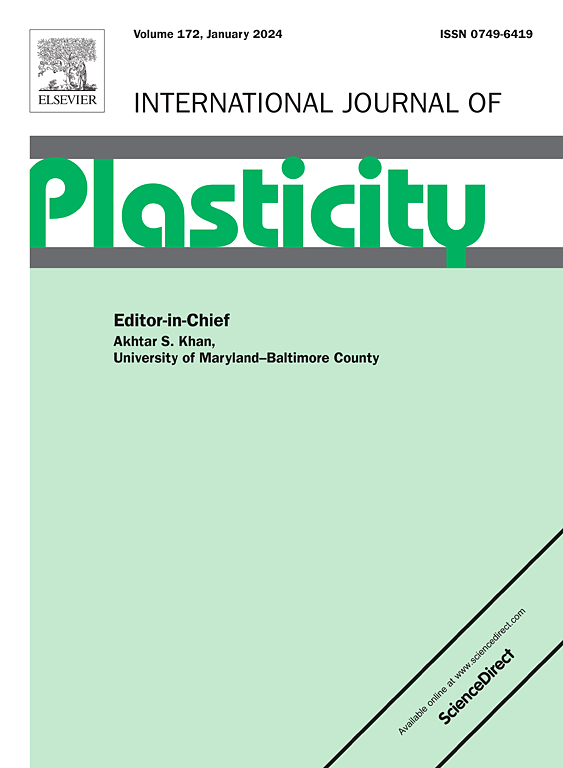Nonlocal crystal plasticity and damage modeling of dual-heterostructured steel for strengthening and failure analysis
IF 9.4
1区 材料科学
Q1 ENGINEERING, MECHANICAL
引用次数: 0
Abstract
Ultrafine elongated grain (UFEG) steel, characterized by its unique multi-level and multi-scale laminated heterogeneous structure, shows considerable promise in addressing the challenge of balancing high strength and toughness in metallic materials. In this work, we develop a coupled nonlocal crystal plasticity and damage phase field model. We derived the dislocation flux term from this model to introduce geometrically necessary dislocation (GND) and back stress to reflect the heterogeneous deformation of the material, and corrected the critical plastic work density term based on the relationship between grain boundary misorientation and grain boundary energy to investigate the strengthening and softening mechanisms of medium carbon steel with UFEG structure under uniaxial tensile deformation. Simulation results indicate that the strengthening effects of GNDs and back stress are closely linked to the material's initial dislocation density and grain size. Higher initial dislocation densities and larger grain sizes limit these effects. Moreover, a higher grain aspect ratio enhances the strengthening effect of GNDs. Different textures significantly affect the tensile properties of the material. The experimentally obtained <110>//RD fiber texture provides some strengthening effect, but there remains a gap compared to the ideal fiber texture. Damage initiates in the elongated grains, but the equiaxed grains help slow its progression. High-angle grain boundaries promote intergranular damage, which restricts the spread of intragranular damage. These boundaries are also critical in the formation of delamination cracks within the BCC material. These insights provide a foundation for understanding the role of grain morphology and GND density in the deformation and failure mechanisms of dual-heterostructured medium carbon steels, offering potential guidance for optimizing microstructure design in these specific material systems.


双异质结构钢的非局部晶体塑性及损伤建模用于强化和失效分析
超细拉长晶粒(UFEG)钢以其独特的多层次、多尺度层状非均质结构,在解决金属材料高强度和高韧性的平衡难题方面具有广阔的前景。在这项工作中,我们建立了一个耦合的非局部晶体塑性和损伤相场模型。在此基础上推导出位错通量项,引入几何必需位错(GND)和背应力,反映材料的非均质变形,并根据晶界取向偏差与晶界能的关系对临界塑性功密度项进行修正,研究UFEG结构中碳钢在单轴拉伸变形下的强化和软化机制。模拟结果表明,gds和背应力的强化效果与材料的初始位错密度和晶粒尺寸密切相关。较高的初始位错密度和较大的晶粒尺寸限制了这些效应。晶粒长径比越大,gds的强化效果越强。不同的织构会显著影响材料的拉伸性能。实验得到的<;110>;//RD纤维织构具有一定的强化效果,但与理想纤维织构相比尚有差距。损伤始于细长晶,但等轴晶有助于减缓损伤的进展。高角度晶界促进了晶间损伤,限制了晶内损伤的扩散。这些边界在BCC材料内分层裂纹的形成中也是至关重要的。这些见解为理解晶粒形态和GND密度在双异质中碳钢变形和破坏机制中的作用奠定了基础,为优化这些特定材料系统的微观结构设计提供了潜在的指导。
本文章由计算机程序翻译,如有差异,请以英文原文为准。
求助全文
约1分钟内获得全文
求助全文
来源期刊

International Journal of Plasticity
工程技术-材料科学:综合
CiteScore
15.30
自引率
26.50%
发文量
256
审稿时长
46 days
期刊介绍:
International Journal of Plasticity aims to present original research encompassing all facets of plastic deformation, damage, and fracture behavior in both isotropic and anisotropic solids. This includes exploring the thermodynamics of plasticity and fracture, continuum theory, and macroscopic as well as microscopic phenomena.
Topics of interest span the plastic behavior of single crystals and polycrystalline metals, ceramics, rocks, soils, composites, nanocrystalline and microelectronics materials, shape memory alloys, ferroelectric ceramics, thin films, and polymers. Additionally, the journal covers plasticity aspects of failure and fracture mechanics. Contributions involving significant experimental, numerical, or theoretical advancements that enhance the understanding of the plastic behavior of solids are particularly valued. Papers addressing the modeling of finite nonlinear elastic deformation, bearing similarities to the modeling of plastic deformation, are also welcomed.
 求助内容:
求助内容: 应助结果提醒方式:
应助结果提醒方式:


